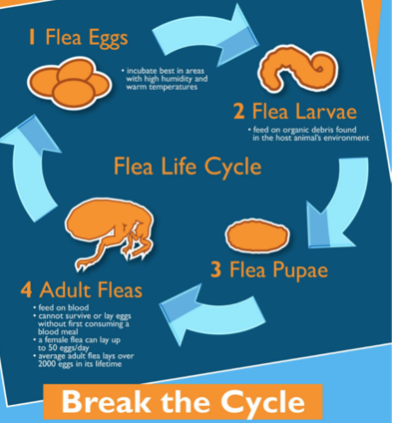Everything you need to know for treatment and prevention
Fleas – what’s the big deal?
Fleas are the most common external parasite we deal with in our pets. They are fast, sneaky, and prolific opportunists who will try to catch a ride and snag a meal from any mammal it can find. It doesn’t matter if your pet never goes outdoors, or you live on the top floor of an apartment building, fleas can find a way into your home and onto your pet.
On top of just being gross, fleas do post a potential health risk for your pet – and for you. Because fleas drink blood, it is possible for a pet to become anemic and possibly die if an infestation is left untreated. It is especially lethal in smaller or younger animals, but the same flea we find on our cats and dogs have been known to kill animals as large as dairy calves. Beyond this risk, they can also cause serious skin issues and transmit infectious diseases and parasites — even to us humans!


Flea Facts and Myths
Myth: Indoor pets cannot catch fleas.
Fact: Fleas thrive in the well-regulated temperatures in the home and can catch a ride on any visitors – including humans – who steps into your home.
Myth: My pet can’t have fleas because I (or someone else) am not being bitten.
Fact: While fleas suck the blood of many species, humans are at the bottom of their preferred meal list and are often a last resort. If a flea infestation is to a point where the human is being bitten the population is very high which means your pets are at a very high risk of anemia and potential death.
Myth: My pet can’t have fleas because I would see them.
Fact: Fleas are the masters of not being seen. They actively avoid the light so they hide in the thickest parts of fur or the undersides of animals. They also don’t live on your animal 100% of the time, sometimes they jump off to avoid an animal licking, chewing, or grooming or to seek out a new host.
What Can I do to prevent fleas?
The number one recommendation for preventing fleas on your pets is to use a parasite preventative product. These come in several different forms: wearable, topical, and oral. They also, unfortunately, come in a wide range of safety and effectiveness – if you ever have questions about which products would be the best for your pet, please reach out to your veterinarian. In the Puget Sound area, we do recommend flea preventatives year round as we don’t see a consistent “die off” of fleas in the area thanks to our temperate climate and the number of reservoir animals in the area. That’s right, it’s always flea season here.
Aside from using preventatives, there are several environmental precautions you can take to make it harder for fleas to enter your house or to make it inhospitable to them.
Outdoors
- Close and secure all crawl spaces.
- Keep dried leaves and overgrown brush away from your house foundation.
- Cut grass, remove weeds, and eliminate leaf debris from the lawn and from the base of trees.
- Discourage stray animals and wildlife from remaining on your property – remove uneaten pet food and bowls and seal trash securely in closed-lid containers.
- Fence off your property to keep strays and wildlife out.
- Avoid elevating storage buildings, or securely blocking access to those areas.
- Regularly inspect, clean, and disinfect dog houses and bedding.
- Regularly clean outdoor furniture and cushions.
- Regularly vacuum the inside of your vehicle if your pet travels with you often.
Indoors
- Regularly vacuum or, if possible, wash your curtains and sofa covers.
- Wash any bedding you can frequently – fleas of all life stages can be found in bedding!
- Vacuum all furniture, carpets, or rugs that your animal sits, sleeps or walks over frequently.
- Don’t forget to vacuum baseboards and hardwood floors!
Cleaning tips!
- Use hot water to wash and hang items in the sun to dry.
- Larvae can cling to carpet fibers when adult fleas cannot! Using something like diatomaceous earth on rugs and carpets lets you kill any insects hiding within before vacuuming them up – be careful when using, it will irritate your (and your pet’s) eyes and throat if it gets kicked up!
What products do we recommend to protect against fleas?
There are dozens of flea preventatives on the market these days, many of which cover several different types of parasites all at once. How do you know which product is best for your pet’s lifestyle? Speak with your veterinarian about which product fits them the best!
Currently, these are the products we recommend the most for parasite protection. It is not all the products we may recommend, but they are the ones we recommend the most frequently.
Dogs
Prescription
- Simparica Trio
- Bravecto
Over the counter
- Activyl
- Vectra 3D
- Advantage
- Advantix
Cats
Prescription
- Bravecto
- Revolution/Revolution Plus
Over the counter
- Cheristin
- Advantage
My pet has fleas! What do I do?
Of all the techniques that have been tried to kill off flea populations, the most successful one is to “break the cycle.” This means we prevent populations from continuing to expand and cause the population over time to die off. Yes, you read that right, this process takes time. The minimum time it takes to break the cycle and kill off an existing population is 3 months.
During this time, we recommend, at a minimum, that every potential host or reservoir in the house is placed on a preventative medication. We can also use all of the environmental preventative measures to knock back the population even more and speed up the process, but we still need 3 months at a minimum to ensure that the population is completely gone before we even consider relaxing any of our measures.
We recommend preventatives year-round for animals in the area — it is much easier to prevent than it is to treat.



